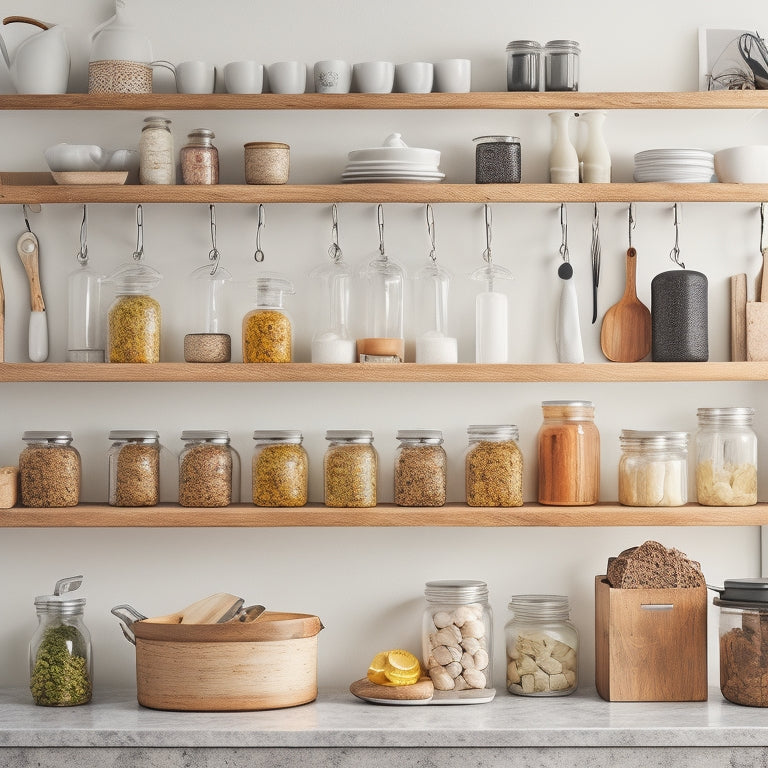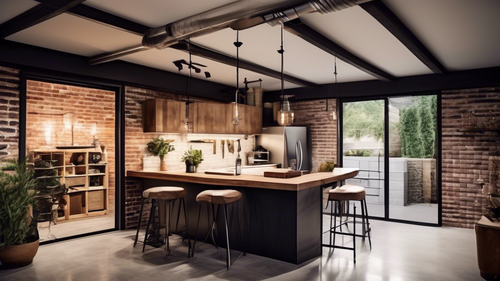
Organize Utensils With 10 DIY Storage Systems
Share
You're tired of cluttered countertops and disorganized drawers cramping your cooking style. It's time to make use of your kitchen's hidden storage potential! Change your space with 10 DIY storage systems, like magnetic spice strips, repurposed mason jars, or an over-the-sink utensil holder. Upcycle an old pallet into a kitchen utensil rack or create a personalized cabinet insert system. For a more customized approach, design adjustable countertop organizers or hanging pot lid holders. With these DIY projects, you'll find new ways to enhance your kitchen's layout, free up counter space, and keep your utensils within easy reach.
Key Takeaways
- Utilize wall space with magnetic spice strips, adhesive hooks, or over-the-sink utensil holders for efficient utensil storage and accessibility.
- Repurpose items like mason jars, wooden crates, or pallets to create unique and functional utensil storage systems that add personal touches to kitchen decor.
- Optimize drawer and cabinet space with customizable dividers, inserts, and shelves that cater to specific utensil storage needs and kitchen configurations.
- Implement adjustable and customizable solutions like countertop organizers and shelf designs that can be tailored to fit specific utensil sizes and kitchen styles.
- Develop an utensil organization plan that groups similar items, stores frequently used utensils in easy-to-reach locations, and adapts to changing storage needs.
Magnetic Spice Strip Organizer
What's holding you back from maximizing that narrow strip of wall space between your countertop and cabinets? A magnetic spice strip organizer is a great way to employ this often-wasted area.
Begin by clearing kitchen countertops and organizing utensils to create a sense of momentum in your decluttering expedition decluttering your physical space. You'll reap the magnetic benefits of easy spice accessibility, keeping your countertops clear and your cooking workflow efficient.
Simply attach a magnetic strip to the wall and start populating it with your favorite spices in their respective containers. You can arrange them alphabetically or by frequency of use, giving you complete control over your kitchen organization.
With this system, you'll be able to grab the spices you need in an instant, streamlining meal prep and cooking time.
Repurposed Mason Jar Storage
Three mason jars line up on your countertop, waiting to be converted into a utensil storage system that's both functional and visually appealing.
With a few simple tweaks, you can reshape these humble containers into a stylish and practical solution for your kitchen. Start by cleaning and decorating the jars with paint, stickers, or ribbons to match your kitchen decor.
Next, attach small labels or chalkboard stickers to identify the contents of each jar.
Finally, fill the jars with utensils like wooden spoons, spatulas, and whisks, and place them on a wooden board or tray.
This repurposed mason jar storage system is a great example of mason jar crafts that add a personal touch to your kitchen decor.
Over-the-Sink Utensil Holder
Install an over-the-sink utensil holder to free up counter space and keep your kitchen organized.
This DIY project is a great way to maintain a clutter-free kitchen while adding a touch of functional design to your kitchen aesthetics.
You'll need a few basic materials, such as a wooden or metal holder, screws, and a drill.
Simply attach the holder to the wall above your sink, making sure it's level and secure.
Then, fill it with your utensils, such as spatulas, whisks, and tongs.
This holder will keep your countertops clear and your utensils within easy reach, making cooking and cleaning a breeze.
Plus, it's a great way to add some visual appeal to your kitchen.
Pallet Kitchen Utensil Rack
You'll start by prepping your pallet, sanding and staining it to match your kitchen's aesthetic.
Next, design the layout of your utensil rack, considering the size and shape of the utensils you'll be storing and the space available on your wall.
With a clear plan in mind, you can move on to organizing your utensils, deciding which ones to hang from hooks, store in baskets, or place on shelves.
Pallet Prep and Design
With your pallet in hand, prepare it for its new life as a kitchen utensil rack by giving it a good cleaning. Remove any dirt, debris, or old packaging materials that may be stuck to it.
You can use a wire brush or sandpaper to scrub off any stubborn stains or rough spots. Once clean, consider applying a pallet treatment, such as a wood sealant or stain, to protect the wood and enhance its appearance.
When sourcing pallets, look for ones in good condition, with sturdy slats and a solid frame. Avoid pallets with broken or missing slats, as they may not be sturdy enough to hold your utensils.
With your pallet prepped and designed, you're ready to move on to the next step: adding your utensil organization system.
Utensil Organization Ideas
Behind the utensil organization system lies a thoughtful arrangement of hooks, bins, and dividers that keep your kitchen tools within easy reach.
You'll want to evaluate the types of utensils you have, such as spatulas, whisks, and tongs, and group them by function or frequency of use. For instance, you might dedicate a section to baking utensils or create a zone for frequently used items like wooden spoons and silicone spatulas.
In a modern kitchen, a sleek and minimalist design might be fitting, while a rustic or vintage-inspired kitchen might call for a more distressed or ornate storage system.
DIY Drawer Dividers System
You'll create a DIY drawer dividers system that keeps your utensils organized and easy to find by employing clever organization methods, like categorizing by type or frequency of use.
To get started, you'll need materials like cardboard, wood, or acrylic dividers, along with a measuring tape and a craft knife.
Utensil Organization Methods
Utensil clutter can make even the most organized kitchen feel chaotic. To regain control, you'll need to implement effective utensil sorting techniques.
Start by categorizing utensils into groups, such as baking, cooking, and serving. Within each group, sort items by frequency of use, with the most frequently used items at the front and center. This will optimize your kitchen space and reduce clutter.
Next, assign a home for each group, ensuring that similar items are stored together. This will make it easy to find what you need when you need it.
Drawer Divider Materials Needed
Now that you've categorized and assigned a home for each utensil group, it's time to create a DIY drawer dividers system to keep them organized. To get started, you'll need to choose the right materials for your drawer layout. Consider the following options:
| Material | Benefits |
|---|---|
| Cardboard | Inexpensive, easy to cut, and eco-friendly |
| Foam Board | Sturdy, yet lightweight, and easy to work with |
| Wood | Durable, customizable, and aesthetic appeal |
These materials will help you create a functional and visually appealing drawer dividers system. Think about your specific needs and preferences when making your material choices. Will you prioritize ease of use, durability, or style?
Customizable Storage Solutions
With your material chosen, it's time to bring your vision to life.
You'll create a DIY drawer dividers system that's customized to your utensil storage needs.
Begin by measuring your drawer's interior and deciding on the number of compartments you want.
Cut your material into modular shelving units, allowing you to personalize the layout as needed.
Next, place flexible containers or bins within each compartment to store utensils, keeping them organized and easy to access.
As you add or remove items, simply adjust the dividers or containers to accommodate your changing needs.
This adaptable system guarantees your utensils are always tidy and within reach.
Adhesive Hook Utensil Hanger
Your kitchen's backsplash or cabinet doors become a convenient utensil hub with the adhesive hook utensil hanger, a space-saving solution that keeps your countertops clear.
You can strategically place these hooks to maximize storage and accessibility.
Consider the following creative hanging options:
- Hang utensils with long handles, like spatulas and whisks, from the backsplash above your countertop.
- Place hooks on cabinet doors to store frequently used items, like spoons and tongs, within easy reach.
- Suspend a row of hooks from the underside of a cabinet to create a hidden utensil organizer.
With adhesive hook placement, you can customize your utensil storage to fit your kitchen's unique layout and your personal preferences.
Upcycled Wooden Crate Shelf
Convert an old wooden crate into a functional utensil storage system that adds a touch of rustic charm to your kitchen. This unique DIY project is perfect for those who appreciate crate aesthetics and want to maximize shelf functionality.
| Materials | Instructions |
|---|---|
| Old wooden crate | Sand and stain the crate to match your kitchen decor |
| Wood screws | Attach the crate to a wall or place it on a countertop |
| Small baskets or containers | Add baskets or containers to store utensils, spices, or oils |
Adjustable Countertop Organizer
As you seek a more efficient way to store your kitchen utensils, consider creating an adjustable countertop organizer that can be customized to your specific needs.
This DIY project allows you to optimize your kitchen space and prioritize utensil accessibility.
- Start by selecting a wooden or plastic base that fits your countertop.
- Add adjustable dividers to separate utensils by type or frequency of use.
- Install a utensil holder or tray to keep frequently used items within easy reach.
With this adjustable countertop organizer, you'll be able to store utensils in a way that makes sense for your cooking style, freeing up space and reducing clutter.
Hanging Pot Lid Organizer
Organizing pot lids can be a challenging task, especially when they're scattered all over the kitchen. A hanging pot lid organizer is a brilliant solution to optimize your kitchen's storage space and efficiency. By installing a vertical organizer, you'll enjoy lid accessibility, clutter reduction, and easy retrieval.
| Material | Design | Benefits |
|---|---|---|
| Wood | Slotted board | Space optimization, easy installation |
| Metal | Grid system | Durable, adjustable, and customizable |
| Plastic | Over-the-door design | Lightweight, easy to clean, and budget-friendly |
| Bamboo | Pegboard design | Eco-friendly, functional, and modern aesthetic |
| MDF | Shelf system | Affordable, easy to assemble, and adjustable |
Choose a material that fits your kitchen style and needs. With a hanging pot lid organizer, you'll experience the joy of kitchen efficiency, improved organization aesthetics, and storage creativity. Get inspired to create your own DIY project today!
Customized Cabinet Insert System
You'll start by creating an utensil organization plan, mapping out which items you want to store and how you'll access them.
Next, you'll design an adjustable shelf system that can be customized to fit your specific cabinet configuration and utensil needs.
With a range of cabinet configuration options to choose from, you can customize your insert system to maximize storage and efficiency.
Utensil Organization Plan
Five minutes of planning can save you hours of frustration in the kitchen. Before diving into your customized cabinet insert system, take a step back and create an utensil organization plan.
This plan will help you determine the most efficient way to store your utensils, making kitchen decluttering a breeze.
Consider the following:
-
Utensil sorting: Group similar items together, such as baking utensils, cooking utensils, and serving utensils.
-
Frequency of use: Store frequently used utensils in easy-to-reach locations, and less frequently used items towards the back or in harder-to-reach areas.
-
Utensil size and shape: Designate specific slots or compartments for each utensil, ensuring a snug fit and preventing clutter from building up.
Adjustable Shelf Design
With your utensil organization plan in hand, it's time to bring your customized cabinet insert system to life with an adjustable shelf design. This feature allows you to customize the shelf height to fit your specific utensil storage needs.
You can choose shelf materials that fit your style, such as wood, metal, or glass. Adjustable shelves also enable you to easily move or remove them as your storage needs change.
Consider incorporating dividers or bins to further optimize your storage space. By adjusting the shelf height, you can create separate compartments for different utensil categories, ensuring everything has its designated spot.
This customization will give you complete control over your utensil storage, making it easy to find what you need when you need it.
Cabinet Configuration Options
Now that you've optimized your shelf design, it's time to focus on configuring your cabinet to maximize storage and accessibility.
You want to create a customized cabinet insert system that fits your specific needs and cabinets styles.
Consider the following configuration options to get the most out of your cabinets:
-
Tiered storage: Install multiple levels of storage within your cabinet to accommodate utensils of different sizes and shapes.
-
Slide-out drawers: Add slide-out drawers or baskets to make it easy to access items in the back of the cabinet without having to dig through everything.
-
Adjustable dividers: Use adjustable dividers to separate utensils and keep them organized, making it easy to find what you need when you need it.
Frequently Asked Questions
Can I Use DIY Storage Systems in a Small Kitchen?
You can totally maximize your small kitchen's potential with DIY storage systems that offer creative organization solutions. By implementing space-saving ideas, you'll create a more functional and visually appealing kitchen that works efficiently for you.
Are DIY Utensil Organizers Easy to Clean and Maintain?
You'll be relieved to know that your DIY utensil organizers can be a breeze to clean and maintain, depending on your material choices and clever cleaning methods, like a gentle soap and water wipe-down or a quick vinegar soak.
Can I Customize DIY Storage Systems to Fit My Kitchen Style?
You can tailor DIY storage systems to fit your kitchen's unique style by incorporating personalized design elements that reflect your kitchen aesthetics, ensuring a seamless blend of form and function that complements your space.
Are DIY Utensil Organizers Suitable for Renters or Temporary Spaces?
You'll find that DIY utensil organizers are perfect for temporary spaces, offering renter-friendly options that are easy to install and remove, providing flexibility and control over your kitchen setup without damaging the walls or leaving a trace.
Do DIY Storage Systems Require Specialized Tools or Skills?
You'll be relieved to know that most DIY storage systems don't require specialized tools or advanced skills; with basic supplies and a bit of creativity, you can create a functional and stylish organizer that suits your needs and space.
Related Posts
-

Transforming Your Garage into a Haven of Style
Is your garage an unorganized chaos of clutter and forgotten dreams? Don't despair! With a little imagination and...
-

5 Best Online Closet Organizer Courses for Success
You're keen to transform your closet organization skills and turn a cluttered space into a haven of tranquility and e...
-

Granite Top Island Design and DIY Installation
You're planning to create a stunning granite top island that enhances your kitchen's functionality and style. To get ...


